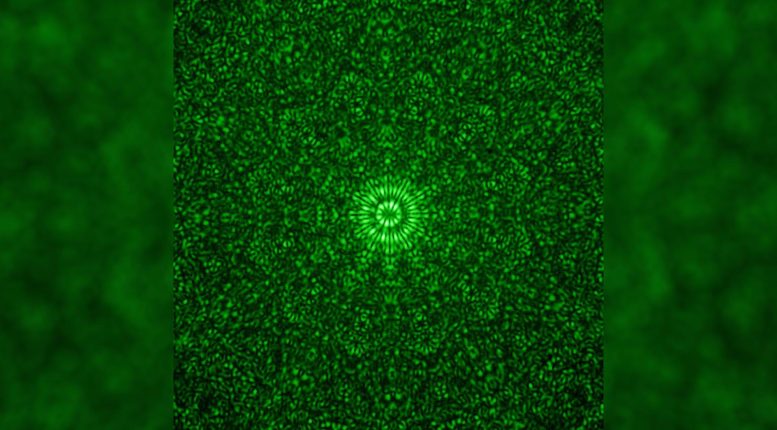

Scientists discovered a way to encode more data into light by creating light vortices with quasicrystals. This method could potentially increase data transmission rates through optic fibers by up to 16 times, marking a significant advancement in telecommunications technology.
Modern life relies heavily on efficiently encoding information for transmission. A common method involves encoding data in laser light and sending it through fiber optic cables. As demand for data capacity grows, finding more advanced encoding methods is essential.
Breakthrough in Light Vortex Creation
Researchers at Aalto University’s Department of Applied Physics have developed a new way to create tiny “hurricanes” of light, called vortices, which can carry information. This technique manipulates metallic nanoparticles that interact with electric fields. The design, based on quasicrystal geometries, was conceived by Doctoral Researcher Kristian Arjas and experimentally realized by Doctoral Researcher Jani Taskinen, both members of Professor Päivi Törmä’s Quantum Dynamics group.
This breakthrough marks a significant advancement in physics and holds promise for innovative approaches to data transmission.
Exploring the Structure of Light Vortices
A vortex is in this case like a hurricane that occurs in a beam of light, where a calm and dark center is surrounded by a ring of bright light. Just like the eye of a hurricane is calm due to the winds around it blowing in different directions, the eye of the vortex is dark due to the electric field of bright light pointing to different directions on different sides of the beam.
Previous physics research has connected what kind of vortices can appear with how much symmetry there is in the structure that produces them. For example, if particles in the nanoscale are arranged in squares the produced light has a single vortex; hexagons produce a double vortex and so on. More complex vortices require at least octagonal shapes.

Now Arjas, Taskinen and the team unlocked a method for creating geometric shapes that theoretically support any kind of vortex.
“This research is on the relationship between the symmetry and the rotationality of the vortex, i.e. what kinds of vortices can we generate with what kinds of symmetries. Our quasicrystal design is halfway between order and chaos,” Törmä says.
Manipulating Nanoparticles for Advanced Information Transmission
In their study, the group manipulated 100,000 metallic nanoparticles, each roughly the size of a hundredth of a single strand of human hair, to create their unique design. The key lay in finding where the particles interacted with the desired electric field the least instead of the most.
‘An electrical field has hotspots of high vibration and spots where it is essentially dead. We introduced particles into the dead spots, which shut down everything else and allowed us to select the field with the most interesting properties for applications,’ Taskinen says.
Future Prospects and Practical Challenges
The discovery opens a wealth of future research in the very active field of topological study of light. It also represents the early steps for a powerful way of transmitting information in domains where light is needed to send encoded information, including telecommunications.
‘We could, for example, send these vortices down optic fiber cables and unpack them at the destination. This would allow us to store our information into a much smaller space and transmit much more information at once. An optimistic guess for how much would be 8 to 16 times the information we can now deliver over optic fiber,’ Arjas says.
Practical applications and scalability of the team’s design are likely to take years of engineering. The Quantum Dynamics group at Aalto, however, have their hands full with research into superconductivity and improving organic LEDs.
The group used the OtaNano research infrastructure for nano-, micro- and quantum technologies in their pioneering study.
Reference: “High topological charge lasing in quasicrystals” by Kristian Arjas, Jani Matti Taskinen, Rebecca Heilmann, Grazia Salerno and Päivi Törmä, 5 November 2024, Nature Communications.
DOI: 10.1038/s41467-024-53952-5

